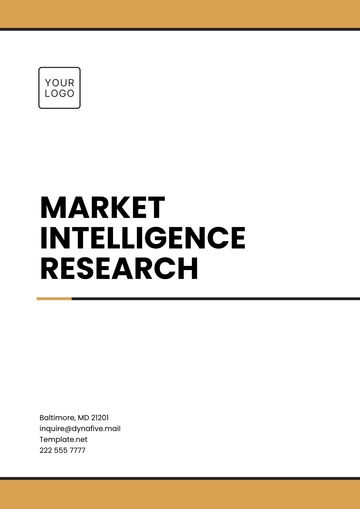Free Agriculture Economic Research

I. Introduction
A. Purpose of the Research
The primary objective of this research is to analyze the economic landscape of the agriculture sector, identifying key trends, cost structures, policy impacts, and technological advancements. This study aims to provide valuable insights that can help stakeholders make informed decisions, enhance productivity, and promote sustainable agricultural practices.
B. Scope and Objectives
The scope of this research covers various aspects of agriculture economics, including market trends, production costs, policy impacts, sustainability practices, and technological innovations. The objectives are:
To analyze global and regional market trends in agriculture.
To assess the cost structures involved in agricultural production.
To evaluate the impact of government policies and regulations on agriculture.
To explore the sustainability of agricultural practices.
To examine the role of technological advancements in modern agriculture.
C. Methodology and Data Sources
This research employs a combination of qualitative and quantitative methodologies. Data is sourced from reputable industry reports, academic journals, government publications, and primary data collected through surveys and interviews with industry experts. Statistical tools and economic models are used to analyze the data and draw meaningful conclusions.
D. About [Your Company Name]
[Your Company Name] is a leading player in the agriculture industry, committed to advancing sustainable and innovative farming practices. With a rich history of agricultural expertise, [Your Company Name] focuses on leveraging cutting-edge technology and research to improve productivity and sustainability in farming. Our mission is to provide high-quality agricultural products while promoting practices that protect the environment and ensure the well-being of our communities. This research reflects our ongoing commitment to understanding and addressing the economic challenges and opportunities within the agriculture sector.
II. Market Trends in Agriculture
A. Global and Regional Market Analysis
The agricultural market is characterized by significant regional variations, influenced by climatic conditions, soil fertility, and socio-economic factors. Globally, major crops such as wheat, corn, and rice dominate the market, with livestock farming being a crucial component in many regions.
Major Crops and Livestock
The table below illustrates the global production of major crops and livestock in [Year]:
Crop/Livestock | Production (Million Tons) | Leading Producers |
|---|---|---|
Wheat | 763 | [Country] |
Corn | 1,144 | |
Rice | 500 | |
Beef | 71 | |
Pork | 114 |
Supply and Demand Dynamics
Supply and demand dynamics are critical in determining market prices and production strategies. While developed countries often have surplus production, developing nations face challenges in meeting domestic demand. This imbalance affects global trade patterns and pricing structures.
B. Price Trends and Forecasts
Historical Price Analysis
Over the past decade, agricultural prices have experienced volatility due to factors such as climate change, geopolitical tensions, and fluctuating demand. For instance, the price of corn peaked in [Year] due to a severe drought in the US, causing global supply shortages.
Future Price Projections
Future price projections indicate a steady increase in prices due to rising global demand and the impacts of climate change. For example, wheat prices are expected to rise by 2-3% annually over the next five years, driven by increased consumption in Asia.
C. Consumer Behavior and Preferences
Consumption Patterns
Consumer behavior in agriculture is shifting towards healthier and organic food options. In developed countries, there is a growing demand for organic produce, while in developing nations, the focus remains on staple crops.
Emerging Trends
Emerging trends in consumer preferences include a rising demand for plant-based proteins and sustainable food products. This shift is driven by increased health awareness and environmental concerns.
III. Cost Structures in Agriculture
A. Input Costs
Seeds, Fertilizers, and Pesticides
Input costs are a significant component of agricultural production expenses. Seeds, fertilizers, and pesticides constitute a major portion of these costs. For instance, the price of high-yield seeds has increased by 15% over the past five years, reflecting advancements in biotechnology and increased demand.
Labor and Machinery
Labor and machinery costs vary significantly across regions. In developed countries, the high cost of labor has led to increased mechanization. In contrast, developing countries rely heavily on manual labor, which is relatively inexpensive.
B. Production Costs
Crop Production Costs
Crop production costs include land preparation, planting, irrigation, and harvesting. For example, the average cost of producing one acre of corn in the US is approximately $600, covering inputs, labor, and machinery.
Livestock Production Costs
Livestock production costs encompass feed, veterinary care, and housing. The table below outlines the average cost of raising different livestock:
Livestock | Average Cost per Head (USD) |
|---|---|
Cattle | 1,200 |
Pigs | 150 |
Chickens | 10 |
C. Marketing and Distribution Costs
Transport and Logistics
Transport and logistics are crucial for getting agricultural products to market. Costs vary depending on distance, infrastructure, and the type of product. For instance, transporting perishable goods like fruits and vegetables requires refrigerated trucks, adding to the overall cost.
Storage and Handling
Storage and handling costs are significant, especially for grains and other non-perishable items. Proper storage facilities are essential to prevent spoilage and maintain product quality.
IV. Policy Impacts on Agriculture
A. Government Policies and Regulations
Government policies and regulations play a vital role in shaping the agricultural sector. Policies related to subsidies, environmental regulations, and safety standards significantly impact agricultural practices and profitability.
Subsidies and Support Programs
Subsidies and support programs are designed to assist farmers by reducing production costs and stabilizing income. For example, the US Farm Bill provides subsidies for crops such as corn, wheat, and soybeans, helping farmers manage price volatility and production risks.
Environmental and Safety Regulations
Environmental regulations aim to promote sustainable farming practices and reduce the environmental impact of agriculture. For instance, the European Union's Common Agricultural Policy (CAP) includes measures to encourage organic farming and reduce the use of harmful pesticides.
B. Trade Policies and Agreements
Trade policies and agreements significantly influence agricultural markets by affecting import and export dynamics. Policies such as tariffs, quotas, and trade agreements impact the competitiveness of agricultural products in the global market.
Import and Export Restrictions
Import and export restrictions can create market distortions, affecting supply and demand. For example, export bans on certain crops during times of domestic shortage can lead to price spikes in the global market.
Trade Agreements and their Effects
Trade agreements such as NAFTA and the EU-Mercosur deal facilitate market access and promote agricultural trade between member countries. These agreements can lead to increased exports, benefiting farmers and the agricultural economy.
C. Taxation and Incentives
Tax policies and incentives are critical in shaping agricultural investments and sustainability practices. Governments often provide tax relief and incentives to promote certain types of agricultural activities.
Agricultural Tax Policies
Agricultural tax policies vary by region and are designed to support farmers. For instance, many countries offer tax exemptions on agricultural income to encourage farming activities.
Incentives for Sustainable Practices
Incentives for sustainable practices include grants, subsidies, and tax breaks for farmers adopting environmentally friendly methods. These incentives aim to promote practices such as crop rotation, organic farming, and the use of renewable energy sources.
V. Agricultural Sustainability
A. Environmental Impact
Agricultural practices have a significant impact on the environment. Sustainable practices are essential to minimize this impact and ensure long-term viability.
Land Use and Soil Health
Sustainable land use practices, such as crop rotation and agroforestry, help maintain soil health and prevent degradation. These practices enhance soil fertility and reduce the need for chemical fertilizers.
Water Resources and Management
Efficient water management is crucial for sustainable agriculture. Practices such as drip irrigation and rainwater harvesting help conserve water and reduce the strain on local water resources.
B. Sustainable Farming Practices
Sustainable farming practices aim to reduce environmental impact while maintaining productivity. These practices include organic farming, agroforestry, and integrated pest management.
Organic Farming
Organic farming avoids the use of synthetic chemicals and promotes natural processes to enhance soil fertility and control pests. This practice is gaining popularity due to its environmental benefits and consumer demand for organic products.
Agroforestry and Crop Rotation
Agroforestry integrates trees and shrubs into agricultural landscapes, providing multiple benefits such as enhanced biodiversity, improved soil health, and additional income streams for farmers. Crop rotation involves alternating different crops in the same field to prevent soil depletion and reduce pest and disease incidence.
C. Economic Viability
Sustainable practices must be economically viable to be widely adopted. This involves analyzing the cost-benefit of sustainable methods and their long-term economic benefits.
Cost-Benefit Analysis of Sustainable Practices
A detailed cost-benefit analysis helps farmers understand the economic implications of adopting sustainable practices. For instance, while organic farming may have higher initial costs, it can lead to higher profits due to premium prices for organic products.
Long-term Economic Benefits
Sustainable practices offer long-term economic benefits by improving soil health, reducing input costs, and enhancing resilience to climate change. These practices can lead to more stable and profitable farming operations over time.
VI. Technological Advancements in Agriculture
A. Precision Agriculture
Precision agriculture involves using advanced technologies to optimize field-level management regarding crop farming. Technologies such as GPS, remote sensing, and data analytics play a crucial role.
GPS and Remote Sensing Technologies
GPS and remote sensing technologies enable farmers to monitor and manage their fields more precisely. These technologies help in mapping fields, monitoring crop health, and identifying areas that need attention, leading to more efficient use of resources.
Drones and IoT in Agriculture
Drones and the Internet of Things (IoT) are revolutionizing agriculture by providing real-time data and automation. Drones are used for aerial surveys, monitoring crop conditions, and applying pesticides, while IoT devices collect data on soil moisture, temperature, and other critical parameters.
B. Biotechnology and Genetic Engineering
Biotechnology and genetic engineering are transforming agriculture by developing crops with enhanced traits such as higher yield, pest resistance, and drought tolerance.
Genetically Modified Crops
Genetically modified (GM) crops are engineered to exhibit specific traits, improving productivity and reducing reliance on chemical inputs. For example, Bt cotton is genetically modified to resist bollworm, a major pest, reducing the need for pesticide application.
CRISPR and Gene Editing
CRISPR and other gene-editing technologies offer precise tools for modifying plant genomes. These technologies can create crops with improved nutritional content, disease resistance, and adaptability to changing climatic conditions.
C. Automation and Robotics
Automation and robotics are increasingly being integrated into agricultural practices to enhance efficiency and productivity.
Automated Machinery and Equipment
Automated machinery and equipment, such as self-driving tractors and robotic harvesters, reduce the labor burden and increase operational efficiency. These machines can perform tasks such as planting, weeding, and harvesting with minimal human intervention.
Smart Farming Systems
Smart farming systems combine automation, IoT, and data analytics to create integrated solutions for farm management. These systems enable real-time monitoring and decision-making, optimizing resource use and improving crop yields.
VII. Policy Impact Analysis
A. Government Subsidies and Support Programs
Government subsidies and support programs play a crucial role in stabilizing agricultural incomes and ensuring food security. These subsidies are designed to help farmers manage price volatility, invest in new technologies, and maintain sustainable practices. For example, in the United States, the Farm Bill provides substantial support through direct payments, crop insurance, and disaster assistance programs. Similarly, the European Union's Common Agricultural Policy (CAP) offers direct payments to farmers, rural development programs, and market measures to stabilize the agricultural sector.
Subsidies can be categorized into various forms such as direct payments, price support, input subsidies, and insurance subsidies. Direct payments provide financial support based on acreage or production levels, helping to stabilize farm incomes. Price support mechanisms ensure that farmers receive a minimum price for their produce, protecting them from market fluctuations. Input subsidies reduce the cost of essential inputs like seeds, fertilizers, and pesticides, making farming more affordable. Insurance subsidies help farmers manage risks associated with natural disasters and crop failures.
B. Trade Policies and International Agreements
Trade policies and international agreements significantly influence the agricultural sector by opening markets, setting standards, and regulating trade flows. The World Trade Organization (WTO) plays a pivotal role in establishing global trade rules, including those related to agriculture. Agreements such as the North American Free Trade Agreement (NAFTA), now replaced by the United States-Mexico-Canada Agreement (USMCA), and the European Union's trade agreements with other countries, impact agricultural exports and imports.
Trade policies can have both positive and negative effects on agriculture. While they can provide access to larger markets and enhance competitiveness, they can also expose domestic farmers to international competition. For instance, free trade agreements can lead to an influx of cheaper imported goods, affecting local farmers' profitability. Conversely, export subsidies and tariffs can protect domestic industries but may lead to trade disputes and retaliatory measures from other countries.
C. Environmental Regulations and Compliance
Environmental regulations are essential for ensuring sustainable agricultural practices and protecting natural resources. These regulations address issues such as water usage, pesticide application, soil conservation, and biodiversity preservation. Compliance with environmental standards often requires farmers to adopt best practices and invest in eco-friendly technologies.
For example, the Environmental Quality Incentives Program (EQIP) in the United States provides financial and technical assistance to farmers who implement conservation practices. The European Union's agri-environmental schemes offer payments to farmers who adopt environmentally beneficial practices. Compliance with these regulations can be challenging and costly, but it is necessary for long-term sustainability.
VIII. Sustainability Practices
A. Sustainable Farming Techniques
Sustainable farming techniques are critical for maintaining soil health, reducing environmental impact, and ensuring the long-term viability of agriculture. Techniques such as crop rotation, cover cropping, conservation tillage, and agroforestry enhance soil fertility, prevent erosion, and improve biodiversity.
Crop rotation involves alternating different crops on the same land to break pest and disease cycles and enhance soil nutrients. Cover cropping involves planting cover crops, such as legumes and grasses, during off-seasons to prevent soil erosion, improve soil structure, and fix nitrogen. Conservation tillage reduces soil disturbance, preserving soil structure and moisture. Agroforestry integrates trees and shrubs into farming systems, enhancing biodiversity, sequestering carbon, and providing additional income sources.
B. Organic Farming and Certification
Organic farming focuses on producing food without synthetic chemicals, genetically modified organisms, and artificial additives. Organic practices include the use of organic fertilizers, biological pest control, and crop diversification. Organic certification, regulated by bodies such as the USDA in the United States and the European Union, ensures that products meet stringent organic standards.
The demand for organic products has been growing due to consumer awareness of health and environmental benefits. However, organic farming presents challenges such as lower yields and higher production costs. Certification processes are rigorous and require adherence to strict standards, but they provide a premium market for certified organic products.
C. Water and Soil Management
Effective water and soil management practices are essential for sustainable agriculture. Water management involves optimizing water use through techniques like drip irrigation, rainwater harvesting, and efficient water storage systems. Soil management focuses on maintaining soil health through practices such as soil testing, nutrient management, and erosion control.
Drip irrigation delivers water directly to plant roots, reducing water wastage and improving crop yields. Rainwater harvesting involves collecting and storing rainwater for agricultural use, reducing dependency on groundwater. Soil testing helps farmers understand soil nutrient levels and tailor fertilization practices accordingly. Nutrient management ensures that crops receive the right amount of nutrients at the right time, minimizing environmental impact. Erosion control practices, such as contour farming and terracing, prevent soil loss and maintain soil fertility.
IX. Technological Advancements
A. Precision Agriculture and Data Analytics
Precision agriculture uses technology to monitor and manage field variability in crops, optimizing inputs like water, fertilizer, and pesticides. Data analytics in precision agriculture involves collecting data through sensors, satellites, and drones, and analyzing it to make informed decisions.
Technologies such as GPS-guided tractors, variable rate technology (VRT), and remote sensing enable farmers to apply inputs precisely where needed, reducing waste and improving yields. Data analytics helps in identifying patterns and trends, allowing for predictive modeling and proactive management of crops. For example, precision irrigation systems use soil moisture data to deliver water precisely where and when it is needed, enhancing water use efficiency.
B. Biotechnology and Genetic Engineering
Biotechnology and genetic engineering are transforming agriculture by developing crops with enhanced traits such as higher yield, pest resistance, and drought tolerance.
Genetically Modified Crops
Genetically modified (GM) crops are engineered to exhibit specific traits, improving productivity and reducing reliance on chemical inputs. For example, Bt cotton is genetically modified to resist bollworm, a major pest, reducing the need for pesticide application.
CRISPR and Gene Editing
CRISPR and other gene-editing technologies offer precise tools for modifying plant genomes. These technologies can create crops with improved nutritional content, disease resistance, and adaptability to changing climatic conditions.
C. Automation and Robotics
Automation and robotics are increasingly being integrated into agricultural practices to enhance efficiency and productivity.
Automated Machinery and Equipment
Automated machinery and equipment, such as self-driving tractors and robotic harvesters, reduce the labor burden and increase operational efficiency. These machines can perform tasks such as planting, weeding, and harvesting with minimal human intervention.
Smart Farming Systems
Smart farming systems combine automation, IoT, and data analytics to create integrated solutions for farm management. These systems enable real-time monitoring and decision-making, optimizing resource use and improving crop yields.
X. Future Trends and Challenges
A. Climate Change and Its Impact
Climate change poses significant challenges to agriculture, affecting crop yields, pest and disease prevalence, and water availability. Rising temperatures, changing precipitation patterns, and increased frequency of extreme weather events can disrupt agricultural production.
Adaptation strategies are essential for mitigating the impact of climate change. These include developing climate-resilient crop varieties, improving water management practices, and adopting sustainable farming techniques. For example, drought-tolerant crop varieties can withstand water scarcity, ensuring stable yields under changing climatic conditions. Efficient water management practices, such as drip irrigation and rainwater harvesting, can help conserve water and enhance resilience.
B. Emerging Technologies
Emerging technologies, such as artificial intelligence (AI), blockchain, and vertical farming, hold promise for transforming agriculture. AI can analyze vast amounts of data to optimize farming practices and predict outcomes. Blockchain technology can enhance transparency and traceability in supply chains, ensuring food safety and reducing fraud. Vertical farming, which involves growing crops in stacked layers, can maximize space use and reduce the need for arable land.
C. Economic and Policy Uncertainties
Economic and policy uncertainties, such as trade tensions, fluctuating commodity prices, and changing regulations, can impact the agricultural sector. Farmers need to navigate these uncertainties and adapt to changing market conditions.
For example, trade disputes can lead to tariffs and trade barriers, affecting export markets and farm incomes. Fluctuating commodity prices can create income volatility, making it challenging for farmers to plan and invest. Changing regulations, such as those related to environmental compliance and food safety, require continuous adaptation and investment in new practices.
D. Sustainable Development Goals (SDGs)
The United Nations' Sustainable Development Goals (SDGs) provide a framework for addressing global challenges, including those related to agriculture. SDG 2 aims to end hunger, achieve food security, improve nutrition, and promote sustainable agriculture. Achieving these goals requires concerted efforts from governments, businesses, and civil society.
[Your Company Name] is committed to contributing to the SDGs by promoting sustainable agricultural practices, enhancing food security, and supporting rural development. By adopting innovative technologies, investing in research, and collaborating with stakeholders, we aim to create a resilient and sustainable agricultural sector that benefits everyone.
- 100% Customizable, free editor
- Access 1 Million+ Templates, photo’s & graphics
- Download or share as a template
- Click and replace photos, graphics, text, backgrounds
- Resize, crop, AI write & more
- Access advanced editor
Conduct thorough economic research with Template.net's customizable and editable Agriculture Economic Research Template. Utilize the AI Editor Tool for precise and detailed analysis. This user-friendly template ensures comprehensive economic insights, enhancing strategic planning and informed decision-making in your agricultural business.





























